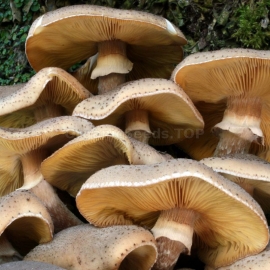 EXCLUSIVE
EXCLUSIVE


Honey Fungus / Armillaria Mellea - Organic Mushroom's Dry Mycelium
6.10 €
Armillaria mellea, commonly known as honey fungus, is a basidiomycete fungus in the genus Armillaria. It is a plant pathogen and part of a cryptic species complex of closely related and morphologically similar species.
-
Organic Honey Fungus Mushroom's Dry Mycelium
Armillaria mellea, commonly known as honey fungus, is a basidiomycete fungus in the genus Armillaria. It is a plant pathogen and part of a cryptic species complex of closely related and morphologically similar species.
It causes Armillaria root rot in many plant species and produces mushrooms around the base of trees it has infected. The symptoms of infection appear in the crowns of infected trees as discoloured foliage, reduced growth, dieback of the branches and death. The mushrooms are edible but some people may be intolerant to them. This species is capable of producing light via bioluminescence in its mycelium.
Armillaria mellea is widely distributed in temperate regions of the Northern Hemisphere. The fruit body or mushroom, commonly known as stump mushroom, stumpie, honey mushroom, pipinky or pinky, grows typically on hardwoods but may be found around and on other living and dead wood or in open areas.
Armillaria mellea mushroom are considered good edibles, although some individuals have reported "allergic" reactions that result in stomach upsets. Some authors suggest not collecting mushrooms from the wood of various trees, including hemlock, buckeye, eucalyptus, and locust. The mushrooms have a taste that has been described as slightly sweet and nutty, with a texture ranging from chewy to crunchy, depending on the method of preparation.
Parboiling mushrooms before consuming removes the bitter taste present in some specimens, and may reduce the amount of gastrointestinal irritants. Drying the mushrooms preserves and intensifies their flavour, although reconstituted mushrooms tend to be tough to eat. Can also be pickled and roasted.
